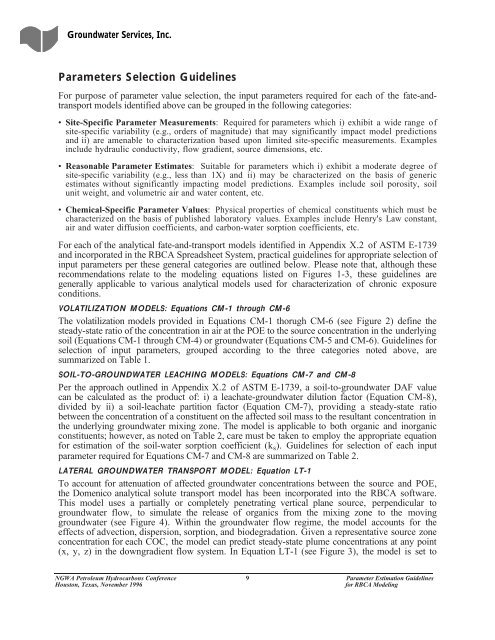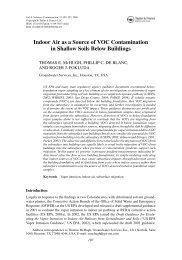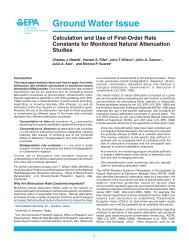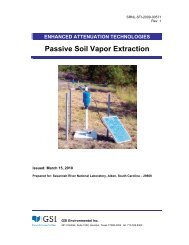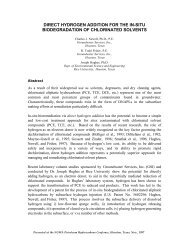Parameter Estimation Guidelines for Risk-Based Corrective Action ...
Parameter Estimation Guidelines for Risk-Based Corrective Action ...
Parameter Estimation Guidelines for Risk-Based Corrective Action ...
You also want an ePaper? Increase the reach of your titles
YUMPU automatically turns print PDFs into web optimized ePapers that Google loves.
Groundwater Services, Inc.<br />
<strong>Parameter</strong>s Selection <strong>Guidelines</strong><br />
For purpose of parameter value selection, the input parameters required <strong>for</strong> each of the fate-andtransport<br />
models identified above can be grouped in the following categories:<br />
• Site-Specific <strong>Parameter</strong> Measurements: Required <strong>for</strong> parameters which i) exhibit a wide range of<br />
site-specific variability (e.g., orders of magnitude) that may significantly impact model predictions<br />
and ii) are amenable to characterization based upon limited site-specific measurements. Examples<br />
include hydraulic conductivity, flow gradient, source dimensions, etc.<br />
• Reasonable <strong>Parameter</strong> Estimates: Suitable <strong>for</strong> parameters which i) exhibit a moderate degree of<br />
site-specific variability (e.g., less than 1X) and ii) may be characterized on the basis of generic<br />
estimates without significantly impacting model predictions. Examples include soil porosity, soil<br />
unit weight, and volumetric air and water content, etc.<br />
• Chemical-Specific <strong>Parameter</strong> Values: Physical properties of chemical constituents which must be<br />
characterized on the basis of published laboratory values. Examples include Henry's Law constant,<br />
air and water diffusion coefficients, and carbon-water sorption coefficients, etc.<br />
For each of the analytical fate-and-transport models identified in Appendix X.2 of ASTM E-1739<br />
and incorporated in the RBCA Spreadsheet System, practical guidelines <strong>for</strong> appropriate selection of<br />
input parameters per these general categories are outlined below. Please note that, although these<br />
recommendations relate to the modeling equations listed on Figures 1-3, these guidelines are<br />
generally applicable to various analytical models used <strong>for</strong> characterization of chronic exposure<br />
conditions.<br />
VOLATILIZATION MODELS: Equations CM-1 through CM-6<br />
The volatilization models provided in Equations CM-1 thorugh CM-6 (see Figure 2) define the<br />
steady-state ratio of the concentration in air at the POE to the source concentration in the underlying<br />
soil (Equations CM-1 through CM-4) or groundwater (Equations CM-5 and CM-6). <strong>Guidelines</strong> <strong>for</strong><br />
selection of input parameters, grouped according to the three categories noted above, are<br />
summarized on Table 1.<br />
SOIL-TO-GROUNDWATER LEACHING MODELS: Equations CM-7 and CM-8<br />
Per the approach outlined in Appendix X.2 of ASTM E-1739, a soil-to-groundwater DAF value<br />
can be calculated as the product of: i) a leachate-groundwater dilution factor (Equation CM-8),<br />
divided by ii) a soil-leachate partition factor (Equation CM-7), providing a steady-state ratio<br />
between the concentration of a constituent on the affected soil mass to the resultant concentration in<br />
the underlying groundwater mixing zone. The model is applicable to both organic and inorganic<br />
constituents; however, as noted on Table 2, care must be taken to employ the appropriate equation<br />
<strong>for</strong> estimation of the soil-water sorption coefficient (k s ). <strong>Guidelines</strong> <strong>for</strong> selection of each input<br />
parameter required <strong>for</strong> Equations CM-7 and CM-8 are summarized on Table 2.<br />
LATERAL GROUNDWATER TRANSPORT MODEL: Equation LT-1<br />
To account <strong>for</strong> attenuation of affected groundwater concentrations between the source and POE,<br />
the Domenico analytical solute transport model has been incorporated into the RBCA software.<br />
This model uses a partially or completely penetrating vertical plane source, perpendicular to<br />
groundwater flow, to simulate the release of organics from the mixing zone to the moving<br />
groundwater (see Figure 4). Within the groundwater flow regime, the model accounts <strong>for</strong> the<br />
effects of advection, dispersion, sorption, and biodegradation. Given a representative source zone<br />
concentration <strong>for</strong> each COC, the model can predict steady-state plume concentrations at any point<br />
(x, y, z) in the downgradient flow system. In Equation LT-1 (see Figure 3), the model is set to<br />
NGWA Petroleum Hydrocarbons Conference 9 <strong>Parameter</strong> <strong>Estimation</strong> <strong>Guidelines</strong><br />
Houston, Texas, November 1996<br />
<strong>for</strong> RBCA Modeling


